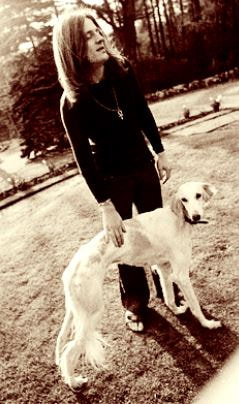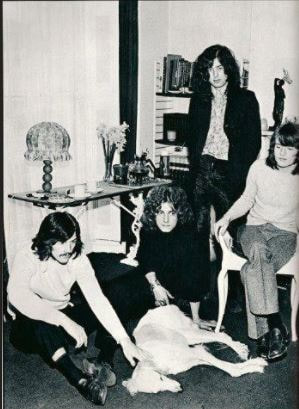
Do You Want a Saluki?
"Yes, we really do feed him." "Yes, he's supposed to be that thin." If you own a Saluki, get ready to say that---a lot! If Greyhounds are the models of the dog world, then the Saluki is the Twiggy of the dog modeling world.
- Many people believe that because they have owned a greyhound or whippet the saluki will be pretty much the same. But keep in mind that while they are all classified as sighthounds, DNA analysis has shown there are two distinct and essentially unrelated families of sighthounds. The first is the British Isle family, which has admixtures of various British herding dogs. These include greyhound, whippet, borzoi, Scottish deerhound, Irish wolfhound and their relations. The second is the Mediterranean family, which includes saluki, Afghan hound, pharaoh hound, Ibizan hound and various Asian and North African breeds. Without benefit of the herding breed influence, it is my opinion that these breeds tend to be slightly less obedient than the British Isle sighthounds. That doesn't mean they can't be obedient, but if your goal is to have a top agility dog, for example, you are better off to stick with a whippet.
- Breeders are fond of extolling how disobedient the breed is, but in my opinion this is hyperbole. Like every breed, it has good and bad points.
- There is no reason a well-bred saluki cannot be an excellent companion, neither destructive, shy nor aggressive. But no, you will not be able to call it off a deer chase. Or even a squirrel.
- Salukis and cats can co-exist peacefully, and most salukis will bow to the cat's superiority. But older salukis may not be able to adjust to cats if they haven't been raised with them. And don't be stupid; don't let your cat out in the yard with three salukis and think they won't chase it if it starts to run. A pack of salukis is not the same as a single saluki, and things can get out of hand.
- Most salukis aren't great dog park candidates, because they are not terribly gregarious with strange dogs, and as their joy is running, they too often become the "bunny" in a large chase that can end up scaring the saluki and getting out of hand.
- Salukis do recognize small dogs as dogs, but if they see a white Maltese running amok in a distant field, they could mistake it for prey before realizing they are giving chase to a dog. This would be rare, but again, use common sense.
- Compared to more "domesticated" breeds, they are less likely to come when called and more likely to give chase to, and even catch and kill, wild animals, especially deer and rabbits.
- The Saluki is a very quiet dog around the house. It sleeps much of the time, but demands its soft cushions.
- They are affectionate, but most are not licky and do not follow you from room to room.
- They are quiet but will bark at real things outside---not leaves falling.
- They are adequate watchdogs but poor protection dogs.
- They are patient with children but may not be playful enough to entertain a child for long. Then they will leave.
- Some, but not all, enjoy playing fetch or Frisbee, or swimming.
- They love to run. REALLY, really love to run.
- Although they are good jumpers, we have only had one that jumped our 4-foot field fencing. Some people have reported their salukis have jumped 5 or even 6 foot fencing, however.
- They enjoy digging cavernous holes in the yard.
- Plan on taking your saluki for a one-hour walk every day, or having plenty of room for it to run inside a fenced area. If started as puppies, you can take a saluki on off-lead hikes, but they will never be completely dependable because they will not resist chasing wildlife far afield.
- They will be the first dog in your obedience class to learn the Stay commands.
- They will be the last dog in your obedience class to learn the Down on hard cold floor command!
- Some tend to be on the timid side.
- They do shed. Not a lot, but they shed. Remember, the feathered variety is a longhaired dog.
- Grooming consists of brushing the body hair about once a week, and combing the fringes twice a week. To protect the long ear fringes, show dogs should wear a snood, or ear covering, that prevents the ears from getting in the food or mouth.
- Neutered and spayed feathered salukis will often grow long hair all over their bodies. Saluki puppies may also have fuzzy hair all over.
- They can be voluntarily thin to the point your neighbors may report you! They do not gulp food indiscriminately.
- If you like to compete, salukis are great at conformation , junior showmanship and lure coursing (and open field coursing), passable at obedience and agility, and rare at most other events.
- In conformation, they are easy for novices to groom and owner-handle.
- In junior showmanship---I recall an article where a successful junior said after careful study she chose a saluki as her juniors dog because more than any other breed it allowed her to show off her versatility; she could stand beside, behind or in front, she could hand stack or free stack, she could kneel or stand, she could move at a flashy speed, and they had just enough hair to show she was attending to it but not so much it was overwhelming. Her prediction proved true, as she was the #1 Junior of all breeds and won the Junior competition at Westminster with her saluki.
- In obedience, six salukis have earned the UD title. None has earned the OTCH.
- In agility, three salukis have earned the MACH title.
- In tracking, seven salukis have earned the TD title. None has earned the TDX.
- Others have won titles in scent work, barn hunt, dock diving and flyball, among others.
- Typical lifespan is 11 to 13 years. Many live well into their teens.
- Hemangiosarcoma, a cancer of the blood vessel lining, is a too common cause of premature death.
- Dilated cardiomyopathy also occurs, as does mitral valve degeneration (the latter usually at an older age).
- Hereditary orthopedic problems, such as hip dysplasia, are rare.
- As a large deep chested breed, salukis should be prone to bloat, but curiously, it is uncommon.
- Lung torsion, while rare, is still more common than in most other breeds.
- Eye problems are rare. In the 1970s there was a report of a saluki with PRA in England that made it into the veterinary literature. Upon the dog's death it was discovered the dog did not have PRA, but that false report has lingered in the literature despite no other "cases" being confirmed.
- Ceroid lipofuscinosis has appeared rarely. There is a DNA test, but the condition is so uncommon I have not heard of anyone testing for it unless they had a dog related to an affected dog. It was first reported in the literature in the 1970s, so since that time the mutation has had plenty of chances to be spread to many different lines. Thus no line can be considered absolutely free unless tested. If ordering the test, be sure to get the one specific for Salukis, as the disease is caused by different mutations in different breeds, and so far this one is saluki-specific.
- Like all sighthounds, salukis have a lower normal T3 and T4 thyroid level. Thyroid testing should be performed at Michigan State University.
- Salukis have blood values similar to Greyhound blood values: that is, higher PCV and lower platelets. Mention this to your veterinarian when running bloodwork.
- Salukis are sensitive to barbiturate anesthesia and it should be avoided.
- Go to Salukihealthresearch.com for more information. Or join the Saluki Health and Genetics Facebook page.
- What health tests should prospective parents have? An echocardiogram is the only one that is really essential, and that won't show much unless the parent is at least middle age. Some breeders also boast of hip, eyes and thyroid, and these are frosting on the cake but so seldom turn up anything most consider them frivolous. Note that in Europe thyroid testing seems to be considered more essential than in North America. To my knowledge if degenerative myelopathy occurs it is rare; I know of no confirmed cases. There are no specific health tests that puppies need aside from routine veterinary exams. Obviously if a line has a history of a possibly hereditary problem the puppies might require more extensive screenings, but this would be unusual.
- Check out Breed Statistics | Orthopedic Foundation for Animals | Columbia, MO (ofa.org) for a listing of saluki stats and for salukis with registered health test results.
- The Saluki Club of America National Specialty is held every year in June near St Louis, MO. Go to www.salukiclub.org for information.
- The American Saluki Association's unofficial national specialty is held every July in Lompoc, CA.
- Many regional Saluki Clubs hold special events. You can find a list at http://salukiclub.org/other-saluki-organizations.html
- In Florida, C-FLASH holds a specialty in Ocala every November.
- You may also meet salukis lure-coursing. Find trials through www.ASFA.org or through the AKC events calendar.
- The SCOA has a Breeder referral page at http://salukiclub.org/breeder-referral.html.
- Adults can sometimes be found through the Saluki Home for Life Facebook page, but it's not a common thing.
- Our rescue organization is www.STOLA.org, but they rarely have dogs.
- Most rescue salukis, such as most of the salukis on PetFinder, are recent or proposed imports from the Middle East. Some of these dogs may have a slightly sharper temperament than those from "western" lines.
- Please meet the parents of your prospective puppy, as we are seeing too many salukis with ugly or shy temperaments these days.
- We are not a CHIC breed, so the club has no official recommendation for health testing. Most breeders agree that a cardiac test with echo should be performed on parents within a year before breeding. Other tests, while nice, are generally icing on the cake.
- More on health: Saluki Health
"Yes, we really do feed him." "Yes, he's supposed to be that thin." If you own a Saluki, get ready to say that---a lot! If Greyhounds are the models of the dog world, then the Saluki is the Twiggy of the dog modeling world.
- The thin appearance is normal and self-imposed. Most Salukis are not big eaters. Ideally they should have three vertebrae, three ribs and both hipbones showing---but just slightly.
- The Saluki comes in two coat types: feathered and smooth. The smooth is caused by a single dominant gene.
- The feathered has long silky hair on its ears, tail, between its toes and on the backs of its legs. It can sometimes have a fuzzy coat on its chest and thighs As puppies, or when spayed or neutered, they may grow long hair over most of their body.
- The smooth has a short hair all over.
- The feathered may be confused with the Afghan Hound, but the feathered Saluki has long hair only on its ears, tail, backs of legs and between toes, and almost never comes in brindle or solid black. The Afghan never comes in spotted or chocolate.
- The smooth may be confused with the Greyhound, Azawakh or Sloughi. Unlike the Greyhound, the Saluki has drop ears, and is usually smaller. The Azawakh has longer legs compared to its height than a Saluki, and often comes in brindle. The Sloughi tends to be heavier boned, and may have a black mask.
- The Saluki is one of the most ancient breeds according to DNA studies and ancient Egyptian carvings.
- It developed over a wide expanse of the Middle East, which is why the breed varies so much is size and looks.
- It was bred to run down gazelles and hares in the desert, often with the aid of falcons. Less commonly it was used to catch wild ass and desert foxes. Salukis are still used today in the Middle East to chase gazelle. They are often muzzled so they don't kill the gazelle.
- The Salukis was referred to as "el hor" (the noble one). They were an exception to the Muslim rule that dogs are unclean. They were allowed to sleep in their nomad owners' tents and were doted upon.
- Salukis appear in many ancient and Renaissance works of art.
- Salukis can still be found in the Middle East living with nomadic tribes, who use them to catch food, and also owned by royalty, who use them to course for sport.
- The Saluki is also called Persian Greyhound or Gazelle Hound.
- The Saluki is a member of the AKC Hound group, and considered a sighthound---a hound that hunts by sight rather than scent.
- The Saluki is the endurance runner of the sighthounds, and is the fastest dog after about a quarter mile.
- Salukis tend to be aloof and independent.
- Saluki rescues are being imported to the West from some Middle Eastern countries.
- The Saluki is one of a very few breeds in which unregistered dogs can be imported and added to the AKC gene pool.
- Four different Salukis (Marjan, Cancer, Fantasia and Treasure) have won the Hound group at the Westminster dog show. Another (Harley) was Reserve Best in Show at the AKC National Championship show.
- The Saluki currently ranks as the 115th most popular AKC breed, down from 110th a decade ago.
- The Saluki is the mascot of Southern Illinois University.
- Celebrities who have owned Salukis include Led Zeppelin's John Paul Jones---and, well, that's it. See photos below. Ken Paves, hairdresser to the stars, owns three Salukis. Orlando Bloom was said to have owned a saluki mix, but it didn't look like one to me. Maybe when he got its skeleton mounted... (Who does that??)
- There is a type of yarn named Bernat Saluki yarn. I have no idea why.



